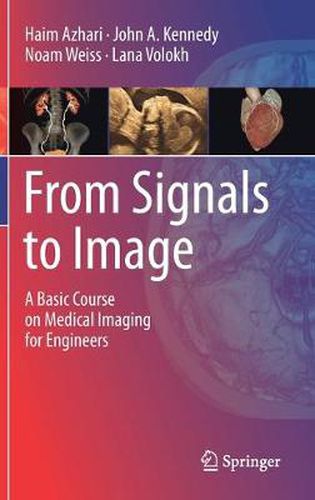Readings Newsletter
Become a Readings Member to make your shopping experience even easier.
Sign in or sign up for free!
You’re not far away from qualifying for FREE standard shipping within Australia
You’ve qualified for FREE standard shipping within Australia
The cart is loading…






This title is printed to order. This book may have been self-published. If so, we cannot guarantee the quality of the content. In the main most books will have gone through the editing process however some may not. We therefore suggest that you be aware of this before ordering this book. If in doubt check either the author or publisher’s details as we are unable to accept any returns unless they are faulty. Please contact us if you have any questions.
This textbook, intended for advanced undergraduate and graduate students, is an introduction to the physical and mathematical principles used in clinical medical imaging. The first two chapters introduce basic concepts and useful terms used in medical imaging and the tools implemented in image reconstruction, while the following chapters cover an array of topics such as physics of x-rays and their implementation in planar and computed tomography (CT) imaging; nuclear medicine imaging and the methods of forming functional planar and single photon emission computed tomography (SPECT) images and Clinical imaging using positron emitters as radiotracers. The book also discusses the principles of MRI pulse sequencing and signal generation, gradient fields, and the methodologies implemented for image formation, form flow imaging and magnetic resonance angiography and the basic physics of acoustic waves, the different acquisition modes used in medical ultrasound, and the methodologies implemented for image formation and flow imaging using the Doppler Effect. By the end of the book, readers will know what is expected from a medical image, will comprehend the issues involved in producing and assessing the quality of a medical image, will be able to conceptually implement this knowledge in the development of a new imaging modality, and will be able to write basic algorithms for image reconstruction. Knowledge of calculus, linear algebra, regular and partial differential equations, and a familiarity with the Fourier transform and it applications is expected, along with fluency with computer programming. The book contains exercises, homework problems, and sample exam questions that are exemplary of the main concepts and formulae students would encounter in a clinical setting.
$9.00 standard shipping within Australia
FREE standard shipping within Australia for orders over $100.00
Express & International shipping calculated at checkout
Stock availability can be subject to change without notice. We recommend calling the shop or contacting our online team to check availability of low stock items. Please see our Shopping Online page for more details.
This title is printed to order. This book may have been self-published. If so, we cannot guarantee the quality of the content. In the main most books will have gone through the editing process however some may not. We therefore suggest that you be aware of this before ordering this book. If in doubt check either the author or publisher’s details as we are unable to accept any returns unless they are faulty. Please contact us if you have any questions.
This textbook, intended for advanced undergraduate and graduate students, is an introduction to the physical and mathematical principles used in clinical medical imaging. The first two chapters introduce basic concepts and useful terms used in medical imaging and the tools implemented in image reconstruction, while the following chapters cover an array of topics such as physics of x-rays and their implementation in planar and computed tomography (CT) imaging; nuclear medicine imaging and the methods of forming functional planar and single photon emission computed tomography (SPECT) images and Clinical imaging using positron emitters as radiotracers. The book also discusses the principles of MRI pulse sequencing and signal generation, gradient fields, and the methodologies implemented for image formation, form flow imaging and magnetic resonance angiography and the basic physics of acoustic waves, the different acquisition modes used in medical ultrasound, and the methodologies implemented for image formation and flow imaging using the Doppler Effect. By the end of the book, readers will know what is expected from a medical image, will comprehend the issues involved in producing and assessing the quality of a medical image, will be able to conceptually implement this knowledge in the development of a new imaging modality, and will be able to write basic algorithms for image reconstruction. Knowledge of calculus, linear algebra, regular and partial differential equations, and a familiarity with the Fourier transform and it applications is expected, along with fluency with computer programming. The book contains exercises, homework problems, and sample exam questions that are exemplary of the main concepts and formulae students would encounter in a clinical setting.